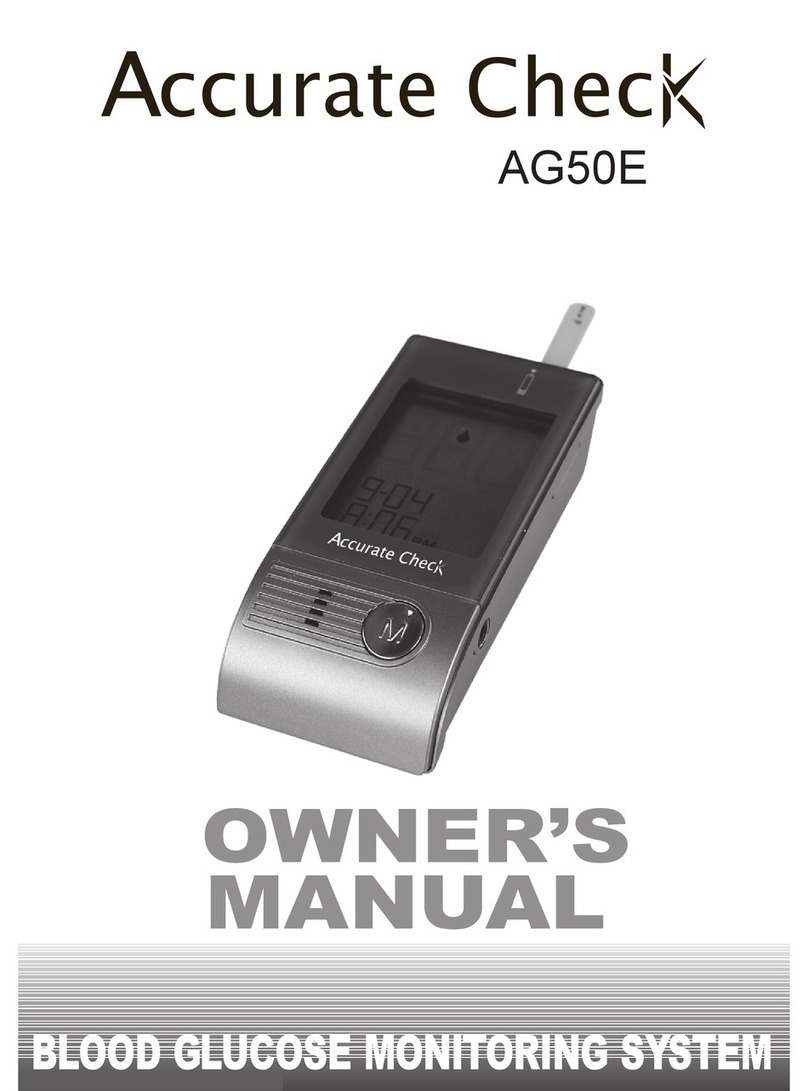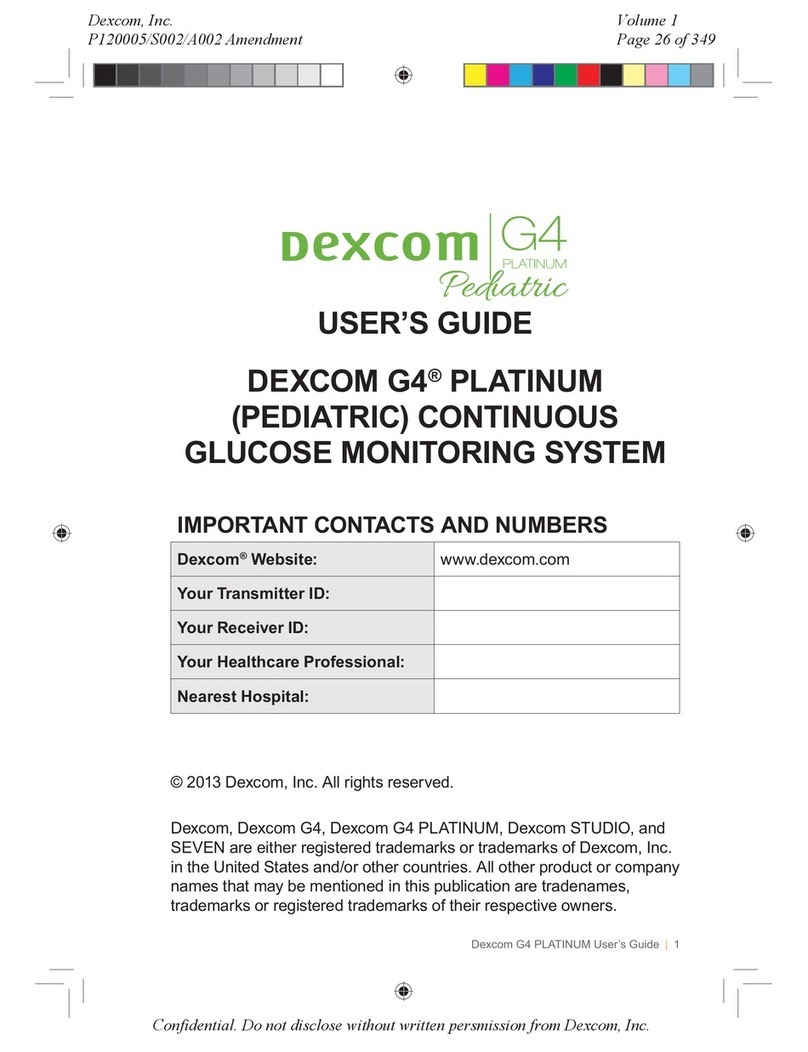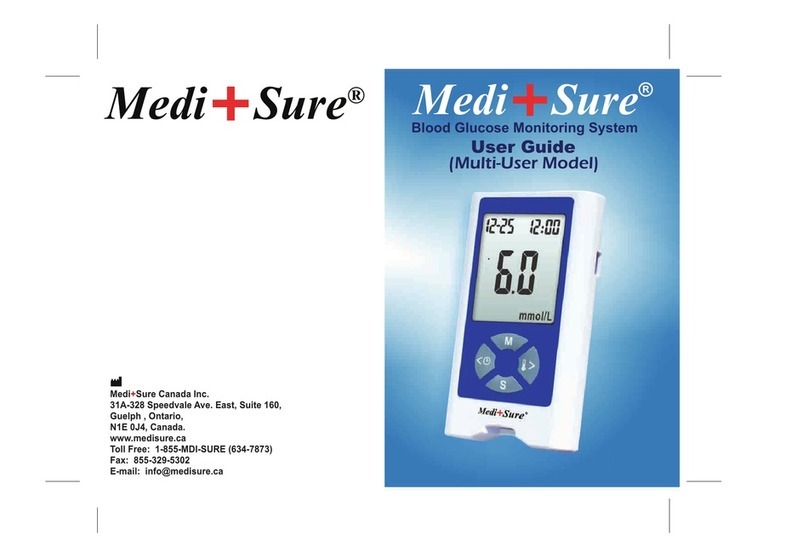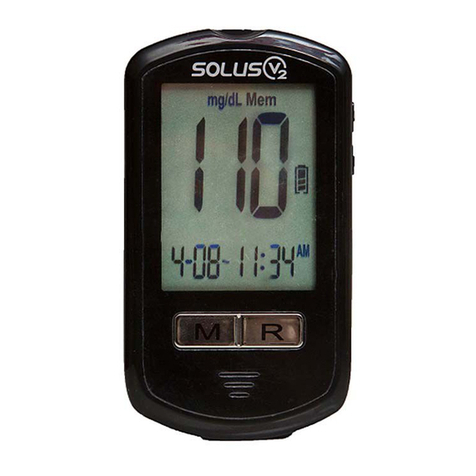Biocare DIAVUE ToGo User manual

Owner’s Manual


TABLE OF CONTENTS
IMPORTANT SAFETY PRECAUTIONS............................................................... 2
Meter Overview .................................................................................................... 5
Meter Overview .....................................................................................................6
SETTING THE METER ............................................................................................8
THE FOUR MEASURING MODES ......................................................................9
BEFORE TESTING ...................................................................................................9
Performing a Control Solution Test ...............................................................10
TESTING WITH BLOOD SAMPLE ......................................................................12
Preparing the Lancing Device for Blood Testing ......................................12
Preparing the Puncture Site .............................................................................12
Performing a Blood Glucose Test ...................................................................13
Alternative Site Testing ......................................................................................15
METER MEMORY ..................................................................................................16
Reviewing Blood Glucose Day Average Results ......................................16
DOWNLOADING RESULTS ONTO A COMPUTER .......................................17
MAINTENANCE .....................................................................................................18
Caring for Your Meter .........................................................................................19
Caring for Your Test Strips ................................................................................19
Important Control Solution Information ...................................................20
SYSTEM TROUBLESHOOTING .........................................................................21
Troubleshooting .................................................................................................22
DETAILED INFORMATION ................................................................................23
SYMBOL INFORMATION ...................................................................................24
SPECIFICATIONS .................................................................................................25

1
Dear DIAVUE ToGo System Owner:
Thank you for purchasing the DIAVUE ToGo Blood Glucose Monitoring System.
This manual provides important information to help you to use the system
properly. Before using this product, please read the following contents
thoroughly and carefully.
Regular monitoring of your blood glucose levels can help you and your
doctor gain better control of your diabetes. Due to its compact size and easy
operation, you can use the DIAVUE ToGo Blood Glucose Monitoring System to
easily monitor your blood glucose levels by yourself anywhere, any time.
If you have other questions regarding this product, please contact the local
customer service or place of purchase.
Intended Use
This system is intended for use outside the body (in vitro diagnostic use) by
people with diabetes at home and by health care professionals in clinical
settings as an aid to monitoring the eectiveness of diabetes control. It is
intended to be used for the quantitative measurement of glucose (sugar) in
fresh whole blood samples from the nger, palm, forearm and upper arm.
It should not be used for the diagnosis of diabetes, or testing on newborns.
Professionals may test with capillary and venous blood sample; home use is
limited to capillary whole blood testing.
Version 2.0 2015/07

2
IMPORTANT SAFETY PRECAUTIONS
READ BEFORE USE
1. Use this device ONLY for the intended use described in this manual.
2. Do NOT use accessories which are not specied by the manufacturer.
3. Do NOT use the device if it is not working properly or if it is damaged.
4. Do NOT under any circumstances use the device on newborns or infants.
5. This device does NOT serve as a cure for any symptoms or diseases.
The data measured is for reference only. Always consult your doctor to have
the results interpreted.
6. Before using this device to test blood glucose, read all instructions
thoroughly and practice the test. Carry out all the quality control checks as
directed.
7. Keep the device and testing equipment away from young children. Small
items such as the battery cover, batteries, test strips, lancets and vial caps
are choking hazards.
8. Use of this instrument in a dry environment, especially if synthetic
materials are present (synthetic clothing, carpets etc.) may cause
damaging static discharges that may cause erroneous results.
9. Do NOT use this instrument in close proximity to sources of strong
electromagnetic radiation, as these may interfere with the accurate
operation.
10. Proper maintenance and periodically control solution test are essential to
the longevity of your device. If you are concerned about your accuracy of
measurement, please contact the local customer service or place of
purchase for help.
KEEP THESE INSTRUCTIONS IN A SAFE PLACE

3

4
BEFORE YOU BEGIN
Important Information
● Severe dehydration and excessive water loss may cause readings
which are lower than actual values. If you believe you are
suering from severe
dehydration, consult a healthcare professional immediately.
● If your blood glucose results are lower or higher than usual, and you do
not have any symptoms of illness, rst repeat the test. If you have
symptoms or continue to get results which are higher or lower than
usual, follow the treatment advice of your healthcare professional.
● Use only fresh whole blood samples to test your blood glucose. Using
other substances will lead to incorrect results.
● If you are experiencing symptoms that are inconsistent with your blood
glucose test results and you have followed all the instructions given in
this owner’s manual, contact your healthcare professional
● We do not recommend using this product on severely hypotensive
individuals or patients in shock. Please consult the healthcare
professional before use.
● The measurement unit used for indicating the concentration of blood or
plasma glucose can either have a weight dimension (mg/dL) or a molarity
(mmol/L). The approximate calculation rule for conversion of mg/dL in
mmol/L is :
For example :
1) 120 mg/dL ÷ 18 = 6.6 mmol/L
2) 7.2 mmol/L x 18 = 129 mg/dL approximately.

5
Meter Overview
➊Test Strip Slot
Insert test strip here to turn the meter on for testing.
➋Test Strip Ejector
Eject the used strip by pushing up this button.
➌Main Button (M)
Enter the meter memory and silence a reminder alarm.
➍Display Screen
➎Data Port
Download test results with a cable connection.
➏SET Button (S)
Enter the meter settings.
➐Battery Compartment

6
Meter Overview

7
Test Strip
ATTENTION : The front side of test strip should face up when inserting test
strip. Test results might be wrong if the contact bar is not fully inserted into
the test slot.
NOTE :
•T h e D I A V U E T o G o m o n i t o r s h o u l d o n l y b e u s e d w i t h D I A V U E T o G o T e s t S t r i p s .
Using other test strips with this meter can produce inaccurate results.

8
SETTING THE METER
Before using your meter for the rst time or if you change the meter battery,
you should check and update these settings.
Entering the Setting Mode (a)
Start with the meter o (no test strip inserted). Press S.
1. Setting the date
The sequence of the date setting is : YEAR →MONTH →DAY.
With the YEAR / MONTH / DAY ashing in sequence, press M until the correct
year/month/day appears. Press S.
2. Setting the time format
Press Mto select the desired time format --- 12h or 24h. Press S.
3. Setting the time
With the HOUR / MINUTE ashing in sequence, press Muntil the correct hour/
minute appears. Press S.
4. Deleting the memory
With “dEL” and “ ” on the display, press Mto select “no” to keep the results
in memory then press Sto skip. To delete all the results, press Mto select “yes”
to delete all the memory records.
5. Setting the reminder alarm
Your meter has four reminder alarms. The meter will display “OFF” and “ ”.
If you don’t want to set an alarm, press Sto skip this step. Or press Mto select
“On”, then press S.
With the hour/minute ashing in sequence, press Mto select the correct hour/
minute. Press Sand go to the next alarm setting.
NOTICE :
When the alarm beeping: Press Mto silence it or press and Hold M
to switch it o. Otherwise, it will beep for 2 minutes then switch itself
o.

9
Congratulations! You have completed all settings!
THE FOUR MEASURING MODES
The meter provides you with four modes for measuring, General, AC,
PC and QC. You can switch between each mode by:
1. Start with the meter switched o. Insert a test strip to turn on the
meter. The screen will display a ashing “ “ and “Gen”.
2. Press Mto switch between General, AC, PC and QC mode.
BEFORE TESTING
Control Solution Testing
Our Control Solution contains a known amount of glucose that reacts
with test strips and is used to ensure your meter and test strips are
working together correctly.
Do a control solution test when :
•you rst receive the meter,
•at least once a week to routinely check the meter and test strips,
•you begin using a new vial of test strips,
•you suspect the meter or test strips are not working properly,
•y o u r b l o o d g l u c o s e t e s t r e s u l t s a r e n o t c o n s i s t e n t w i t h h o w y o u
feel,or if you think the results are not accurate,
•practicing the testing process, or
•you have dropped or think you may have damaged the meter.
NOTE :
• These parameters can ONLY be changed in the setting mode.
•If the meter is idle for 3 minutes during the setting mode, it will switch off
automatically.

10
Test strips (c), control solutions (d), lancing device (e) or sterile lancets (f) may
not be included in the kit (please check the contents on your product box).
They can be purchased separately. Please make sure you have those items
needed for a blood glucose test beforehand.
Performing a Control Solution Test
To perform a control solution test, you will need: (b), (c) and (d).
1. Insert the test strip to turn on the meter
Insert the test strip into the meter. Wait for the meter to display the “ “
and “ ”..
2.Press M to mark this test as a control solution test
With “QC” displayed, the meter will not store your test result in memory under
“QC”. If you press Magain, the “QC” will disappear and this test is no longer a
control solution test.
3. Apply control solution (g)
Shake the control solution vial thoroughly before use. Squeeze out the rst
drop and wipe it o, then squeeze out another drop and place it on the tip of
the vial cap. Hold the meter to move the absorbent hole of the test strip to
touch the drop. Once the conrmation window lls completely, the meter will
begin counting down.
NOTE :
• To avoid contaminating the control solution, do not directly apply control
solution onto a strip.
WARNING :
•When doing the control solution test, you have to mark it so that the test result will
NOT be stored in the memory. Failure to do so will mix up the blood glucose test
results with the control solution test results in memory.

11
4. Read and compare the result
After counting down to 0, the control solution test result will appear on the
display. Compare this result with the range printed on the test strip vial and
it should fall within this range. If not, please read the instructions again and
repeat the control solution test
NOTE :
•The control solution range printed on the test strip vial is for control solution use
only. It is not a recommended range for your blood glucose level.
•See the MAINTENANCE section for important information about your control
solutions.

12
Warning :
To reduce the chance of infection :
• Never share a lancet or the lancing device.
•Always use a new, sterile lancet. Lancets are for single use only.
•Avoid getting hand lotion, oils, dirt, or debris in or on the lancets and the lancing
device.
TESTING WITH BLOOD SAMPLE
Preparing the Lancing Device for Blood
Testing
Please follow the instructions in the lancing device insert for collecting a
blood sample.
Preparing the Puncture Site
Stimulating blood perfusion by rubbing the puncture site before blood
extraction has a signicant inuence on the glucose value obtained.
Blood from a site that has not been rubbed exhibits a measurably dierent
glucose concentration than blood from the nger. When the puncture site
was rubbed prior to blood extraction, the dierence was signicantly reduced.
Please follow the suggestions below before obtaining a drop of blood :
⊙Wash and dry your hands before starting.
⊙ Select the puncture site either at ngertips or another body parts
(please see section “Alternative Site Testing” (AST) on how to select the
appropriate sites).
⊙ Clean the puncture site using cotton moistened with 70% alcohol and
let it air dry.
⊙ Rub the puncture site for about 20 seconds before penetration.
⊙ Use a clear cap (included in the kit) while setting up the lancing
device.

13
NOTE :
• Choose a dierent spot each time you test. Repeated punctures at the same spot may
cause soreness and calluses.
•Please consult your health care professional before you begin AST.
•It is recommended that you discard the rst drop of blood as it might contain tissue
uid, which may aect the test result.
⊙Fingertip testing (h)
Press the lancing device’s tip rmly against the lower side of your
ngertip. Press the release button to prick your nger, then a click
indicates that the puncture is complete.
⊙Blood from sites other than the ngertip (i)
Replace the lancing device cap with the clear cap for AST. Pull the cocking
control back until it clicks. When lancing the forearm, upper arm or hand,
avoid lancing the areas with obvious veins because of excessive bleeding.
Performing a Blood Glucose Test
To perform a blood glucose test, you will need: (b), (c), (e) and (f).
1. Insert the test strip to turn on the meter
Wait for the meter to display the “ ” and “ ”.
2. Select the appropriate measuring mode by pressing M.
3. Obtaining a blood sample (j)
Use the pre-set lancing device to puncture the desired site. Wipe o the rst
appeared drop of blood with a clean cotton swab. The size of the drop should
be at least as big as ●(actual size), which is 0.5 microliter (μL) of volume. Gently
squeeze the punctured area to obtain another drop of blood. Be careful NOT
to smear the blood sample.
4. Apply the sample (k)
Gently apply the drop of blood to the absorbent hole of the test strip at a
tilted angle. Confirmation window should be completely filled if enough

14
blood sample has been applied. Do NOT remove your nger until you hear a
beep sound.
5. Read Your Result
The result of your blood glucose test will appear after the meter counts down
to 0. The blood glucose result will be stored in the memory automatically.
6. Eject the used test strip (l)
Eject the test strip by pushing the eject button on the side. Use a sharp bin to
dispose of used test strips. The meter will switch itself o automatically.
Always follow the instructions in the lancing device insert when removing
the lancet.
NOTE :
•Do not press the punctured site against the test strip or try to smear the blood.
•If you do not apply a blood sample to the test strip within 3 minutes, the meter will
automatically turn o. You must remove and reinsert the test strip to start a new test.
•The confirmation window should be filled with blood before the meter begins to
count down. NEVER try to add more blood to the test strip after the drop of blood has
moved away. Discard the used test strip and retest with a new one.
• If you have trouble lling the conrmation window, please contact your health care
professional or the local customer service for assistance.
WARNING :
•The used lancet and test strip may be biohazardous. Please discard them carefully
according to your local regulations.

15
Alternative Site Testing
You can test on a variety of locations on your body.
Important :
There are limitations with AST
(Alternative Site Testing).
Please consult your health
care professional before you
perform AST.
When to use AST?
Food, medication, illness, stress and exercise can aect blood
glucose levels. Capillary blood at the ngertip reects these changes
faster than capillary blood at other sites. Thus, when testing blood
glucose during or immediately after a meal, physical exercise, or any
other event, take a blood sample from your nger only.
We strongly recommend that you perform AST ONLY at the following times :
⊙In a pre-meal or fasting state (more than 2 hours since the last meal).
⊙Two hours or more after taking insulin.
⊙Two hours or more after exercise.
Do NOT use AST if :
⊙You think your blood glucose is low.
⊙You are unaware of hypoglycemia
⊙You are testing for hyperglycemia
⊙Your AST results do not match the way you feel.
⊙Your routine glucose results often uctuate.

16
METER MEMORY
The meter stores the 450 most recent blood glucose test results
along with respective dates and times in its memory. To enter the
meter memory, start with the meter switched o.
Reviewing Test Results
1. Press and release M.
“ ” will appear on the display. Press M again, and the rst reading you
see is the last blood glucose result along with date, time and the measuring
mode.
2. Press Mto recall the test results stored in the meter each time you press.
After the last test result, press M again and the meter will be turned o.
Reviewing Blood Glucose Day Average
Results
1. Press and release M. When “ ” appears on the display, keep
pressing Mfor 3 seconds until the ashing “ ” appears.
Release Mand then your 7-day average result measured in general mode will
appear on the display.
2. Press M to review 14-, 21-, 28-, 60- and 90- day average results stored in
each measuring mode in the order of Gen, AC, then PC.
3. Exit the meter memory.
Keep pressing the Mand the meter will turn o after displaying the last test
result.
NOTE:
• Any time you wish to exit the memory, keep pressing Mfor 5 seconds or leave it
ithout any action for 3 minutes. The meter will switch o automatically.
•Control solution results are NOT included in the day average.

17
DOWNLOADING RESULTS ONTO A
COMPUTER
Data Transmission via Cable
You can use the meter with a RS232 cable and the Health Care Software
System to view test results on your personal computer. To learn more about
the Health Care Software System or to obtain a RS232 cable separately, please
contact the local customer services or place of purchase for assistance.
1. Obtaining the required cable and installing the software
To download the Health Care Software System, please visit the BioCare
website : www.biocare.com
2. Connecting to a personal computer
Connect the cable to a RS232 port on your computer. With the meter switched
o, connect the other end of the RS232 cable to the meter data port. “PC” will
appear on the meter display, indicating that the meter is in communication
mode.
3. Data transmission
To transmit data, follow the instructions provided with the software. Results
will be transmitted with date and time. Remove the cable and the meter will
automatically switch o.
WARNING :
•While the meter is connecting to the PC, it will be unable to perform a blood glucose
test.
Table of contents
Other Biocare Blood Glucose Meter manuals
Popular Blood Glucose Meter manuals by other brands
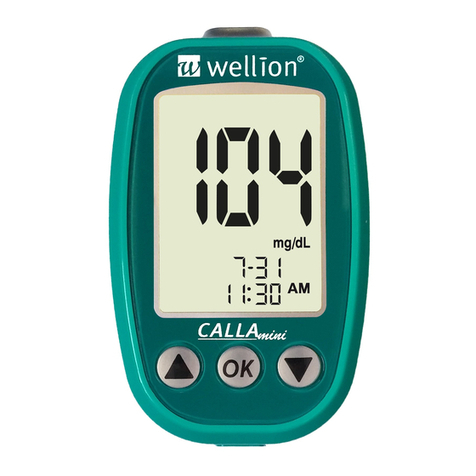
Wellion
Wellion CALLA mini owner's guide

TaiDoc Technology Corporation
TaiDoc Technology Corporation PLUS One owner's manual

Lifescan
Lifescan ONETOUCH ULTRA2 Test instructions
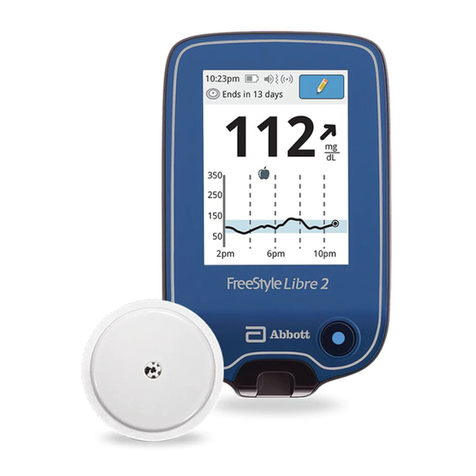
Freestyle
Freestyle Libre 2 quick start guide
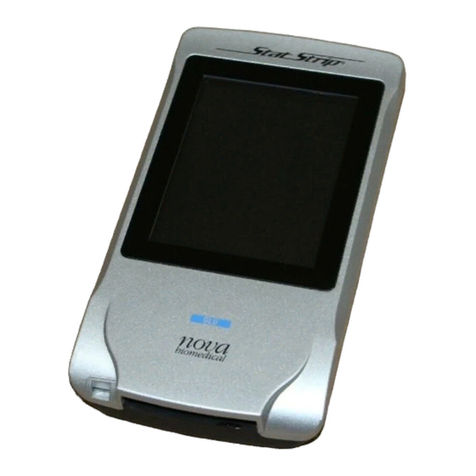
AIDIAN
AIDIAN Nova StatStrip Brief instructions
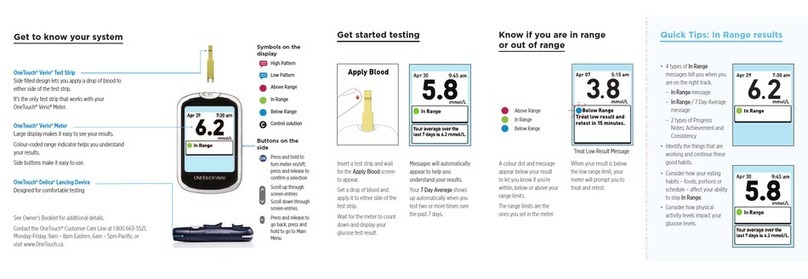
OneTouch
OneTouch Verio Get started guide

Accu-Chek
Accu-Chek Aviva Quick start guides
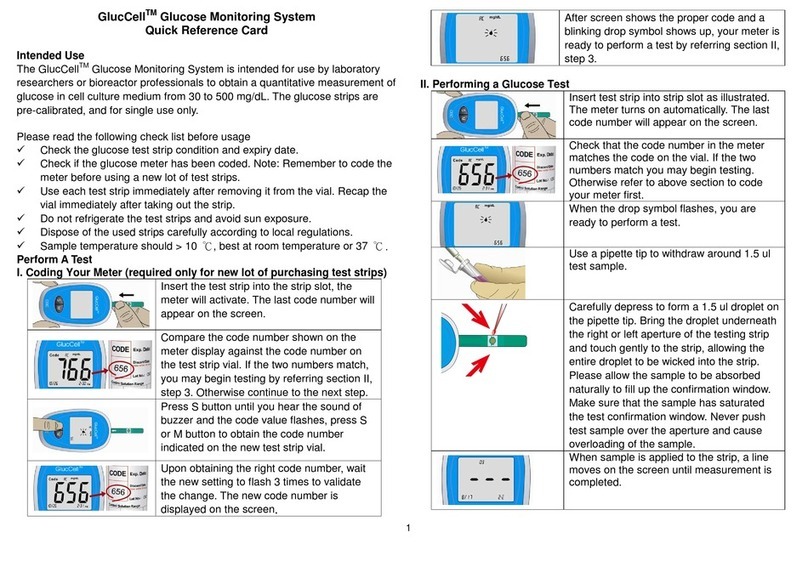
CESCO
CESCO GlucCell Quick reference card

Arkray
Arkray Assure PRISM MULTI manual
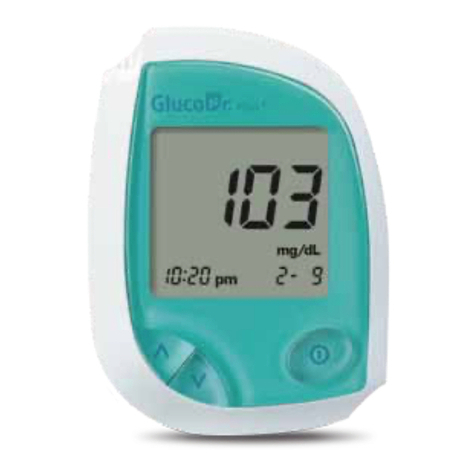
Medicus
Medicus Gluco Dr. Plus user manual
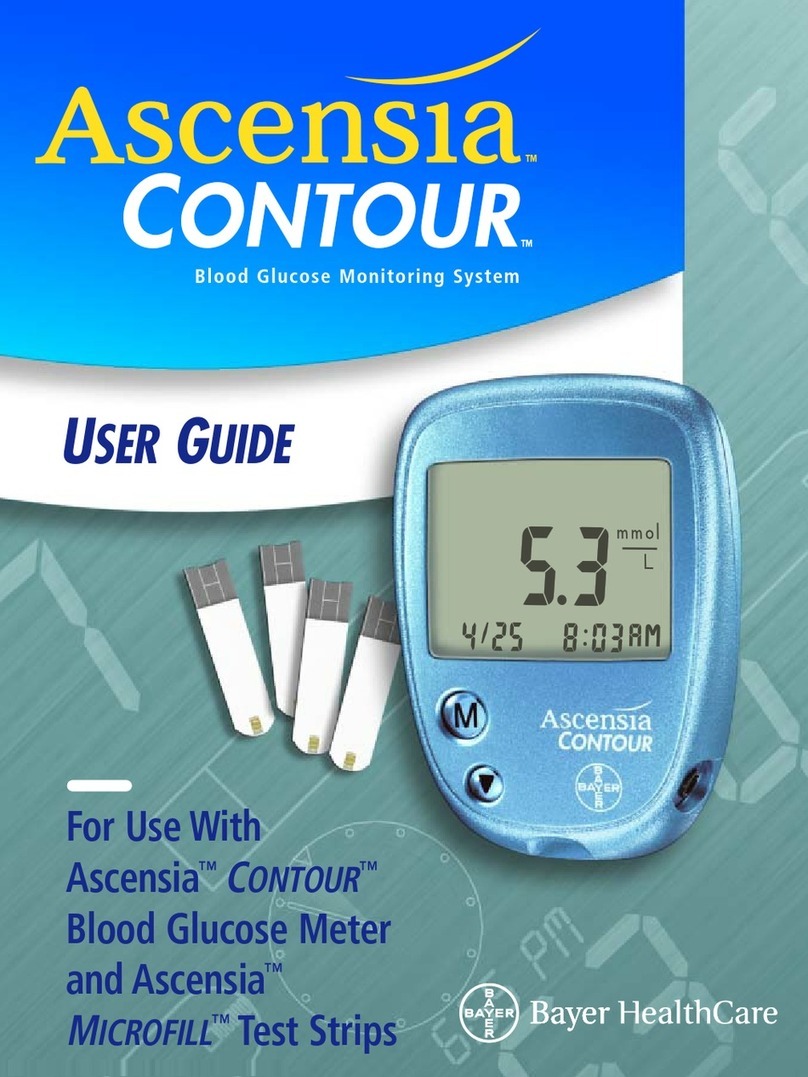
Bayer HealthCare
Bayer HealthCare Ascensia Contour Blood Glucose Monitoring... user guide
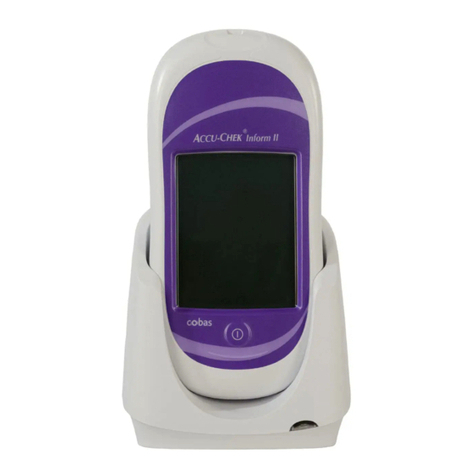
Accu-Chek
Accu-Chek Inform II Addendum to the Operator Manual
